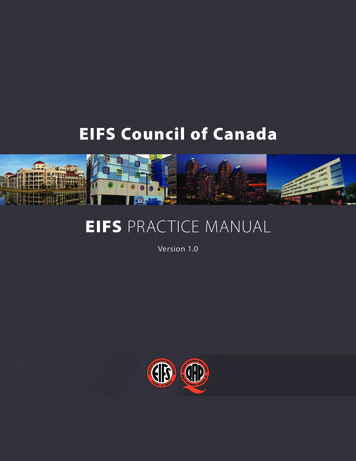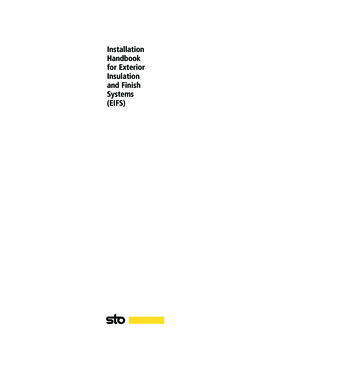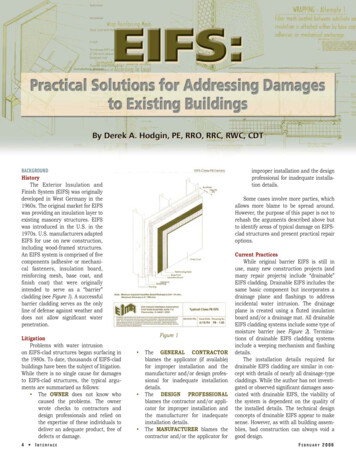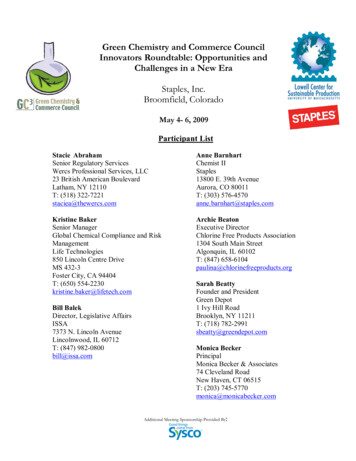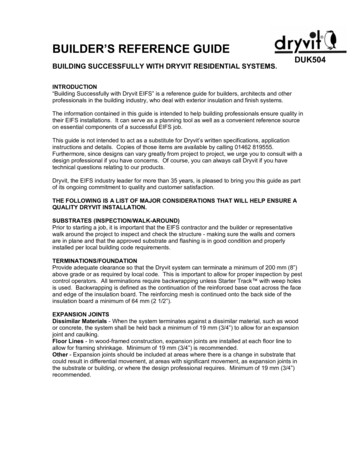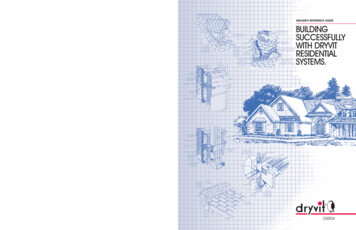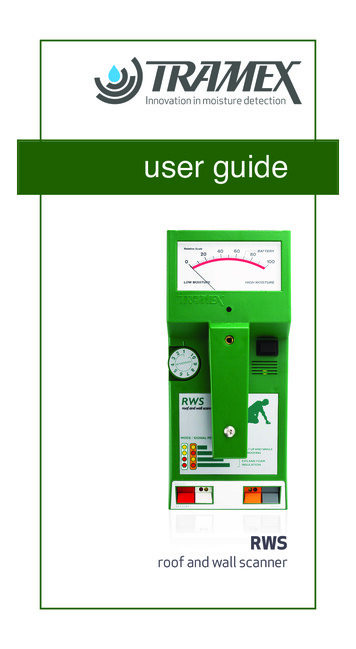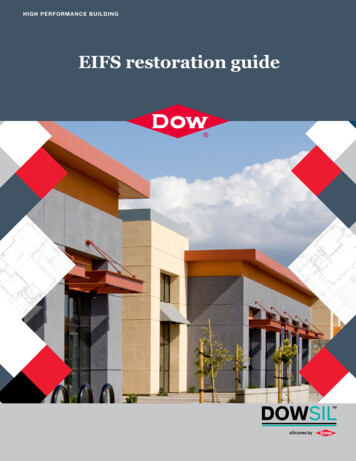
Transcription
H IG H P E RFO RM A NCE BUI L DI NGEIFS restoration guide
ContentsIntroduction . .3EIFS joint failure overview .3Adhesive failure of sealant .3Sealant deterioration . .3Cohesive failure of sealant .4Delamination of the EIFS coating .4Products for EIFS restoration .4Silicone weatherproofing sealants .4Prefabricated silicone seal .4Waterproof coatings .5Primers . .5EIFS restoration methods .5Recessed joint .5Joint removal . .5Joint reconstruction .6Joint overlay.6Wall restoration .6EIFS restoration procedures . .6Recessed joint .6Joint removal . . 7Joint reconstruction . 7Joint overlay.8Field adhesion test procedures . .9For DOWSIL 123 Silicone Seal . .9For DOWSIL AllGuard Silicone Elastomeric Coating 11Warranties . 11References .12This document is intended to provide installation and fieldtesting instructions for DOWSIL brand sealants, coatingsand primers for EIFS applications in order to provide buildingowners the longest lasting weatherproofing system available.While this guide provides product-specific EIFS restorationprocedures, the recommendations in this guide are notintended to replace those of a qualified industry consultantor engineer who can investigate and evaluate the existingcondition of a particular EIFS building.2
IntroductionThe purpose of this guide is to discuss why and how to useDOWSIL brand sealants, DOWSIL 123 Silicone Seal andDOWSIL AllGuard Silicone Elastomeric Coating for therestoration of Exterior Insulation and Finish Systems (EIFS)and joints within or adjacent to the EIFS. Dow offers a systemsapproach to the restoration of EIFS that cannot be matchedby any other manufacturer. Rather than a temporary fix, theDow EIFS Restoration System offers long-term waterproofingsolutions to leaking EIFS buildings.The recommendations in this guide are not intended to replacethose of a qualified industry consultant or engineer who caninvestigate and evaluate the existing condition of a particularEIFS building. Problems associated with EIFS can be complexand may not be repaired through improved waterproofing of thebuilding facade alone. Water penetration through faulty jointsor at terminations of the EIFS may cause substantial damagein the EIFS or the underlying structure that must be addressedseparately from the waterproofing. Addressing certain designflaws such as the failure to allow proper water drainage from awindow system, overheating of expanded polymer styrene (EPS)insulation, or excessive deflections due to poor foundations arebeyond the scope of this document. It is strongly encouragedthat a qualified industry consultant be hired in these cases.In the following sections, various EIFS restoration alternatives willbe discussed. Since no single method is best for all situations,each restoration method should be considered. To assist indetermining which restoration method is best, a mockup ofthe restoration method or methods should be installed on thebuilding. Dow will assist at the job site to help determine whichrestoration method is best suited for each particular building.Silicones are better DOWSIL one-component silicone sealants do not requirespecial mixing, unlike multicomponent polyurethanesealants. DOWSIL silicone sealants have been tested andrecommended by most major EIFS manufacturers foruse with their systems. DOWSIL silicone sealants are UV stable and arevirtually unaffected by outdoor weathering. Siliconesealants have a life expectancy of greater than 20 yearscompared to 5 to 10 years of life expectancy for manyorganic polyurethane sealants. DOWSIL 790 Silicone Building Sealant, the preferredsealant for EIFS expansion joints, has unparalleled ultralow modulus properties, movement capability of 100/-50percent and a proven 20 year performance on buildings. Inorganic silicone sealants have more stable modulusand remain flexible in cold temperatures as comparedto organic polyurethane sealants which stiffen in coldtemperatures. The following graph compares the modulusof DOWSIL 790 Silicone Building Sealant with amulticomponent polyurethane at room temperatureand cold conditions:DOWSIL 790Silicone ess, psi25 C (77 F)-18 C (0 F)Modulus is determined at 23 percent elognation in a ½” x ½” (13 mm x 12 mm) tensileadhesion joint pulled at 2”/min (51 mm/min). Cured samples were conditioned for24 hours prior to testing.EIFS joint failure overviewBecause EIFS joints may fail for several reasons, the failuremode of the sealant joint should be examined to determinewhich restoration method is feasible or preferred. The followingsections describe the four basic types of sealant joint failuresand their possible causes.Adhesive failure of sealantAdhesive failure is a loss of bond or adhesion of the sealant toa substrate. This failure may occur for three primary reasons:improper use of primer, failure to use a primer or improper surfacepreparation. If field adhesion testing had been performed atinstallation, the results should have dictated surface preparationrequirements. Most sealants require the use of a primer. If testingindicates that a specific primer should be used, failure to use thatprimer or improper use of the primer may cause adhesive failure.Adhesive failure may also be the result of an improperlyprepared substrate. The substrate must always be clean,dry and frost-free prior to sealant installation. Adhesion maybe reduced if the EIFS coating is not fully dry. An improperlyprepared substrate is a common source of adhesive failureof sealant in a joint.Sealant deteriorationUp until the past several years, multicomponent polyurethanesealants were used on most EIFS buildings. Polyurethanesealants are organic materials that deteriorate in the presenceof ultraviolet light. This deterioration manifests itself in lossof sealant flexibility and movement capability, or in someinstances, reversion of the sealant from a cured to an uncuredstate. It is not uncommon for polyurethane sealed joints toexperience sealant failure within 5 to 10 years. Total sealantdeterioration or reversion of a polyurethane sealant is one ofthe most difficult joint failure modes in EIFS to restore.Deterioration in the form of hardening of the sealant willcause a greater stress to be exerted at the bondline with eachextension and compression. This will typically manifest itselfin adhesive failure caused by the greater stress or cohesivefailure in the EIFS because the EIFS structure can be weakerthan the force exhibited. These are among the most commontype failures.3
Cohesive failure of sealantCohesive failure occurs when a sealant tears or splits withinitself as the result of joint movement. Cohesive failure isusually the result of the sealant no longer being able toaccommodate the expansion and contraction of the joint. Asealant is expected to have a certain movement capability asdetermined by the sealant manufacturer. Sealants are eitherdesignated by categories of 12½ percent, 50 percent or 100/-50 percent initial movement capability. However, manypolyurethane sealants will stiffen and show a loss in movementcapability over time. As a result, joint movement may causecohesive failure of a stiffened sealant.Joint movement on a percentage basis is also affected by thesize of the joint. For example, ¼” (6-mm) movement on a ½”(13-mm) wide joint will be twice as much on a percentage basisas a ¼” (6-mm) movement on a 1” (25-mm) wide joint. Therefore,narrower joints are more prone to cause failure of the sealant.Cohesive failure may be the result of the sealant joint profile.The ideal joint profile might be viewed as the compromisebetween two undesirable extremes. Lesser sealant depthallows for greater movement capability of the sealant, butbecause organic sealants may degrade on the surface, thejoint is susceptible to cohesive failure. Thicker sealant depthensures compensation for weathering of the sealant surfacebut reduces sealant movement capability and increases theforces exerted on the joint and the potential for joint failure.Delamination of the EIFS coatingExcessive sealant depth will reduce movement capability ofthe sealant, increasing the potential for substrate failure.Delamination occurs when the sealant overstresses the coating.This can happen at any time, but is particularly prone to occurwhen the EIFS coating is softened by prolonged exposure tomoisture or water. Delamination of the EIFS coating can oftenbe attributed to the incorrect use of open-cell polyurethanebacker rod. The absorptive nature of open cell polyurethanebacker rod allows moisture to continuously contact the EIFScoating causing softening of the EIFS coating and increasing thepotential for delamination during joint extension. EIFS requiresthe use of closed-cell polyethylene or non-gassing polyolefinbacker rods to perform successfully.Until recently, EIFS manufacturers specified that their acrylicfinish coat be applied into the joint. This coating is particularlyvulnerable to softening when wet, and as a result, finish coatdelamination is a common source of EIFS joint failure. EIFSmanufacturers now require that the finish coat be stopped atthe face of the joint and that the sealant be applied to the moremoisture-stable basecoat or an acrylic paint color primer on thebasecoat. Both the basecoat and color primer are more stablein a wet environment and are less susceptible to delaminationwhen stressed by a sealant during joint extension.The other significant factor contributing to EIFS coatingdelamination is the modulus or stiffness of the sealant. Aspreviously discussed, some sealants, and especially somepolyurethane sealants, stiffen with age. A polyurethane sealantthat may initially be low modulus might become noticeablyless flexible after weathering.4Polyurethane sealants also have the inherent propertyof increasing 2 to 3 fold in sealant modulus in coldtemperatures. This is a particular disadvantage with EIFSbecause in cold temperatures, a joint has its greatestextension. A polyurethane sealant becomes a stiff, highmodulus sealant in cold temperatures creating a tremendousamount of stress on the EIFS coating. The combinationof a soft EIFS coating and a stiff polyurethane sealant incold temperatures is a probable cause of most finish coatdelamination and joint failure in EIFS.Products for EIFS restorationSilicone weatherproofing sealantsDOWSIL 790 Silicone Building Sealant is the premiumexpansion joint sealant for EIFS. With ultralow modulus, highmovement capability of 100/-50 percent, DOWSIL 790Silicone Building Sealant can perform in joints where othersealants would fail. This sealant is intended for EIFS-to-EIFSjoints and requires the use of a DOWSIL brand primer forall EIFS applications. Consult your Dow representative forspecific EIFS systems tested and approved. DOWSIL 790Silicone Building Sealant is available in 11 standard colorsand pre-matched custom colors for EIFS.DOWSIL 791 Silicone Weatherproofing Sealant is a lowcost, high-performance sealant intended for EIFS-to-metalapplication and expansion joints with certain EIFS systems.This sealant features 50 percent movement capability andprimerless adhesion to most EIFS manufacturers’ systems.DOWSIL 791 Silicone Weatherproofing Sealant is availablein seven standard colors.DOWSIL 795 Silicone Building Sealant is a high-performancesealant intended for use at EIFS perimeters and certain EIFSexpansion joints. The sealant features excellent primerlessadhesion to most EIFS systems. DOWSIL 795 SiliconeBuilding Sealant is available in 11 standard colors and prematched custom colors for EIFS.Since EIFS manufacturers do not permit the use of opencell polyurethane backer rod with their systems, use eitherDOWSIL 791 Silicone Weatherproofing Sealant or DOWSIL 795 Silicone Building Sealant in joints where the EIFS isadjacent to nonporous or metal surfaces.Prefabricated silicone sealDOWSIL 123 Silicone Seal is the key product in theDOWSIL EIFS Restoration System. This prefabricatedsilicone strip, when used in conjunction with DOWSIL 795Silicone Building Sealant as an adhesive and DOWSIL AllGuard Silicone Elastomeric Coating, provides a low-cost,long-term waterproofing system for EIFS buildings. Theultralow modulus DOWSIL 123 Silicone Seal, which featuresmovement capability of 200/-75 percent, produces minimalstress on an EIFS finish coat (3 psi [0.021 MPa] at 25 percentelongation). DOWSIL 123 Silicone Seal can be textured andcustom designs can be provided to your specifications.
Waterproof coatingsDOWSIL AllGuard Silicone Elastomeric Coating is a 100percent silicone latex water-based elastomeric coating intendedfor the waterproofing of masonry, stucco and EIFS buildings.Unlike acrylic elastomeric coatings, DOWSIL AllGuard SiliconeElastomeric Coating offers the long-term weatherabilityand flexibility of DOWSIL silicone sealants. This coatingis available in 55 standard colors and a full range of customcolors that are made to order at your distributor’s facility.DOWSIL AllGuard Silicone Elastomeric Coating, whenused in conjunction with DOWSIL 123 Silicone Seal, offersunlimited color flexibility in waterproofing an EIFS building.PrimersDOWSIL 1200 OS Primer is a solvent-based, adhesionpromoting primer intended to be used with DOWSIL sealants.DOWSIL 1200 OS Primer is compatible with EIFS and canalso be used on adjacent metal if priming is required.DOWSIL P5200 Adhesion Promoter is a mixture of air-drying,moisture-reactive materials diluted in a non-VOC volatilemethylsiloxane fluid designed to improve the adhesion of a widevariety of DOWSIL sealants to most metals, glass, ceramics,wood, concrete and many plastics.EIFS restoration methodsFour restoration methods are offered for the repair andrestoration of EIFS and EIFS joints. Any of the four methods maybe appropriate for your specific building. The failure mode ofthe existing sealant joint will help to dictate which is the mostcost-effective and practical restoration method. Mockups ofthe selected methods should be installed to help determineappropriateness of each repair method. Dow will assist youin helping you make this determination. Certain restorationmethods will require the assistance of an EIFS manufacturer.Following is an overview of each restoration method and adiscussion of the advantages and disadvantages of each method.The following section includes the specific procedures for eachrestoration method.Recessed jointIn situations where the failed existing joint has been recessedinto the joint, it is possible to install a new sealant joint overthe old sealant joint without removing the failed sealant. Theexisting sealant must be recessed at least ½” (13 mm) from theface of the joint to allow a new sealant joint to be installed.Recess of greater than ½” (13 mm) may allow a closed-cellbacker rod or foam tape to be installed. Slit the existingsealant before applying a bond breaker tape over it in the joint.(See Figure 1, page 6.)The advantage of this method is that the joint can be madewatertight without changing the appearance of the joint. Also,this method is fairly cost-effective since removal of the oldsealant is not required.A potential disadvantage of this procedure results from thefinish coat having likely been installed into the joint. Any newsealant will probably be installed to the finish coat unlessthe additional step of removing the finish coat of the EIFS isperformed. Dow sealants have excellent adhesion to bothfinish and base coats of EIFS. While Dow is not responsiblefor the integrity of the EIFS coating and potential delaminationof the EIFS coating under stress, the use of a low-modulussilicone, such as DOWSIL 790 Silicone Building Sealant, willensure the best possible joint performance.Joint removalThe joint removal restoration method includes completeremoval of all existing sealant and installation of new sealant.The challenging aspect of this procedure is the removal of theold sealant.Removal of a reverted polyurethane sealant becomes verycostly and time consuming due to the gummy nature of thedeteriorated organic sealant. The gummy sealant is extremelydifficult to remove from EIFS substrates without the use ofsolvents, which can damage the underlying foam insulationboard. The EIFS cannot be easily abraded without causingdamage to the coating and mesh. If the mesh is damaged,reconstruction of the joint will be required.If joint failure is due to finish coat delamination and the sealantis not reverted or gummy, joint removal may be more costeffective than other methods.Removal of a cured failed silicone sealant is much easier thanthe removal of a failed organic sealant. A silicone that is curedand has failed in adhesion on one side of the joint can becleanly cut away from the other side of the joint with a knife,and the remainder abraded away.It may be possible to remove the old sealant and finish coatwithout damaging the EIFS base coat and mesh. The useof knives, wire wheel abrasion and grinders may effectivelyremove the old sealant and finish coat. Job site mockuptesting must be performed to evaluate the viability of thisprocedure. (See Figure 2, page 7.)5
Joint reconstructionReconstruction of an EIFS joint is the most costly and laborintensive method of joint restoration. This method involvescutting into the EIFS and reinstalling EIFS base coat, mesh,color primer and/or finish coat to match the original jointcondition. The EIFS manufacturer would be involved insupplying the procedures and appropriate EIFS coatings tomatch the existing coating. In lieu of the application of a newEIFS finish coating, DOWSIL AllGuard Silicone ElastomericCoating from Dow can be used to waterproof and coat theentire EIFS wall.The reconstruction method would be appropriate if joints aresized too small to accommodate joint movement. The useof joint movement indicators can help assess whether jointsare of sufficient width for a sealant to perform properly. Jointreconstruction also would be appropriate if a new penetration,such as a window, air conditioner, lighting fixture or otherattachment, is being installed (see Figure 3, page 7). Jointreconstruction may also be necessary if the original EIFSdesign did not allow for the proper positioning of an expansionjoint. It may be necessary for an EIFS manufacturer or industryconsultant to evaluate this condition. In the reconstructionmethod, the sealant installation is as it would be with a newEIFS installation.Joint overlayThe joint overlay restoration method allows for waterproofingof joints in a cost-effective means that does not requirereconstruction of the joint or removal of failed sealant. Anoverlay joint, commonly referred to as a bridge joint or bandaid joint, spans the existing sealant joint from the face of oneside of the joint to the other. Traditionally, these joints havebeen applied in the field with a wet sealant such as DOWSIL 795 Silicone Building Sealant. Field-applied silicone overlayjoints have a proven track record of performance on EIFS andother construction materials.With the introduction of DOWSIL 123 Silicone Seal, thevariability of field applied overlay joints has been eliminated.DOWSIL 123 Silicone Seal is the ideal choice for EIFSjoint restoration. DOWSIL 123 Silicone Seal can provide avery cost-effective, watertight joint due to the labor savingsassociated with not having to remove the failed organicsealant. DOWSIL 123 Silicone Seal is applied directly overthe failed joint using DOWSIL 795 Silicone Building Sealantas the adhesive (see Figures 4 - 6, page 8). With the assistanceof a Dow representative, a field mockup can be installed todemonstrate the performance of this product with your system.When used in conjunction with DOWSIL AllGuard SiliconeElastomeric Coating, these Dow products provide a completesilicone solution for failed EIFS joints.When an EIFS wall is showing hairline cracks of ¹/₁₆” (1.6 mm)or less, DOWSIL AllGuard Silicone Elastomeric Coatingcan effectively bridge the hairline cracks and waterproof thewall. The DOWSIL AllGuard Silicone Elastomeric CoatingApplication and Maintenance Guide, Form No. 62-617, outlinesthe proper installation for DOWSIL AllGuard SiliconeElastomeric Coating on EIFS.In areas where hairline cracks are in excess of ¹/₁₆” (1.6 mm)width, there may be need for a control or expansion joint at thislocation. An EIFS expert should be consulted in these cases.If a new joint cannot be installed by the joint reconstructionmethod, the use of an overlay joint is effective. For an irregularhairline crack, a field-applied wet sealant application with aDow sealant is recommended. DOWSIL AllGuard SiliconeElastomeric Coating then can be applied over the entire wall toensure a watertight wall should further hairline cracks develop.EIFS restoration proceduresRecessed joint restoration procedureThis procedure is intended where the existing joints allow for anew sealant joint to be installed over the existing sealant joint.Prior to initiating sealant installation, a field adhesion test jointmust be installed to verify sealant adhesion in the joint.1. Clean the existing EIFS joint surface using a nonmetallic,stiff-bristle brush. Clean all adjacent metal surfaces with asolvent by the “two cloth” cleaning method. Any residue ofthe old sealant on the new joint surface must be completelyremoved. Mechanical abrasion with a wire brush may benecessary to remove old sealant residue. Blow all dust fromthe joint surface with oil-free compressed air.2. Slit the existing sealant joint and apply a polyethylene orTeflon bond breaker tape over the sealant. The bond breakertape should be ½” (13 mm) wide or greater depending onthe existing joint width. A closed-cell foam bond breakertape may be necessary to provide a maximum sealant depthof ⅜” (9 mm) for the tooled sealant.3. Apply an appropriate DOWSIL primer to the EIFS andadjacent metal surfaces in a light coat using a soft-bristlebrush or lint-free cloth. Avoid applying primer onto adjacentsurfaces. Allow primer to dry before installing sealant.4. Install DOWSIL sealant to allow a minimum bond of ¼”(6 mm) on the side of the joint. Sealant depth of ⅛” to ⅜”(3 to 9 mm) at the center of the joint is recommended.Figure 1. Recessed joint restorationEPS insulationWall restorationRestoration of the EIFS wall beyond the existing joints can becomplex, requiring the need for a qualified industry consultantwho is experienced in EIFS restoration. Provided that the wallis essentially sound, waterproofing and restoring the wall canbe accomplished with the use of Dow sealants and DOWSIL AllGuard Silicone Elastomeric Coating.6Existing backer rodExisting failed sealantBond breaker/backerBase coat withreinforcing meshNew DOWSIL sealantFinish coat
Joint removal restoration procedureThis procedure is best suited where joint failure is the resultof finish coat delamination and the existing organic sealanthas not reverted. Prior to initiating sealant installation, a fieldadhesion test joint must be installed to verify sealant adhesionin the joint.1. Cut out as much of the existing sealant as possible. Removeand discard old backer rod.2. Using mechanical abrasion, completely remove all tracesof the existing sealant from the EIFS and adjacent metalsurfaces. If present, remove the existing finish coat from theinside of the joint. The use of a diamond tipped grinder ormechanical wire wheel abrasion has proven successful forthis use. Extreme care must be taken to avoid damaging theexisting base coat and reinforcing mesh.3. To remove all dust and loose particles, blow joints with oilfree compressed air. The joints must be thoroughly clean,dry and frost-free before installing sealant or additionalbase coat.4. If base coat is damaged, it must be repaired with anappropriate EIFS base coat. An EIFS manufacturer must beconsulted for advice in this situation. In most cases, the EIFSmanufacturer will recommend a colored primer for use overthe base coat.5. After EIFS coatings are allowed to dry, install DOWSIL primer, backer rod and DOWSIL sealant in accordancewith Dow guidelines.Figure 2. Joint removal restoration3. The existing finish surrounding the new joint must be grounddown to base for a space of 4” to 6” (102 to 152 mm) back fromthe edge of the joint so that new finish coat can be applied.4. All substrates must be thoroughly dry, dust-free and frostfree before applying the new coating.5. Apply new base coat to the exposed edge of the EPS boardand onto the prepared face of the wall adjacent to the joint6. Embed mesh into this new base coat making sure that the EPSboard edge is completely protected and the mesh is broughtonto the face of the wall where the finish has been removed.7. Apply the EIFS manufacturer’s colored primer to the insideof the joint if required and allow it to dry completely.8. Install the EIFS finish coat to match the existing finish up tothe edge of the joint. Due to the difficulty of matching thenew finish with the existing, it may be necessary to recoatan entire wall section after modifications have been made.DOWSIL AllGuard Silicone Elastomeric Coating can beused in lieu of an EIFS coating to provide a uniform finishand waterproofing of the EIFS wall.9. Install DOWSIL primer, backer rod and Dow sealant inaccordance with Dow guidelines. DOWSIL AllGuardSilicone Elastomeric Coating may be applied directlyover cured DOWSIL sealant joints. Install DOWSIL AllGuard Silicone Elastomeric Coating in accordancewith the DOWSIL AllGuard Silicone Elastomeric CoatingApplication and Maintenance Guide, Form No. 62-617.Figure 3. Joint reconstruction – new penetrationEPS insulationExisting EIFS wallsNew backer rodNew EIFS base coatwith reinforcing meshNew DOWSIL sealantBase coat withreinforcing meshNew DOWSIL sealantFinish coatJoint reconstruction restoration procedureThis procedure can be used when replacing a failed sealantjoint, widening a joint, adding a new expansion joint, creatinga joint through the addition of a new opening in the wall orcreating a new opening for an air conditioner. At all timesfollow the EIFS manufacturers’ recommendations for theproper installation of their EIFS. This procedure is approvedby the EIFS Industry Members Association (EIMA).Backer rodNew air conditionerpenetration1. Cut through the EIFS with a sharp knife or saw so thatdamage to the EPS is minimal. Make this cut approximately¼” to ⅜” (6 to 9 mm) wider than the desired dimension of thenew joint so that the sealant can be installed later.2. Remove the unwanted EIFS materials and substrate andrepair any damage to the EPS board.7
Joint overlay restoration procedureThis method is best suited when it is not feasible to remove failedsealant without damaging the EIFS. An overlay joint may beinstalled with a DOWSIL sealant alone or utilizing DOWSIL 123 Silicone Seal with DOWSIL 795 Silicone Building Sealantas an adhesive. Refer to the DOWSIL AllGuard SiliconeElastomeric Coating Application and Maintenance Guide, FormNo. 62-617, and current product literature for more information.Prior to initiating sealant installation, a field adhesion test jointmust be installed to verify sealant adhesion in the joint.1. Using a nonmetallic, stiff-bristle brush, abrade the surfaceof the EIFS finish coat adjacent to the joint. Solvent cleanany adjacent metal surface by the “two cloth” cleaningmethod. Blow all dust from the joint surface with oil-freecompressed air.2. Mask the surface of the EIFS to provide a clean edge for theoverlay joint.Figure 4. Joint overlay restoration usingDOWSIL sealantEPS insulationExisting backer rodExisting failed sealantBasecoat with Taped edgereinforcing (removedafter sealantmeshinstallation)New DOWSIL sealantFigure 5. Joint overlay restoration – fillet jointat window perimeterEPS insulation3. Slit the existing sealant joint. Apply a polyethylene or Teflonbond breaker tape over the existing sealant joint only if a wetsealant joint is to be installed. DOWSIL 123 Silicone Sealdoes not require a bond breaker tape.4. If necessary, as determined through a field adhesion testjoint, apply DOWSIL primer to the EIFS surface of thejoint. (DOWSIL 790 Silicone Building Sealant typicallyrequires primer on EIFS and metal; DOWSIL 791 SiliconeWeatherproofing Sealant and DOWSIL 795 Silicone BuildingSealant typically do not require primer on these substrates.)5. When installing a wet sealant overlay joint, apply and toolsealant in a flat strip or fillet bead over the old joint and ontoeach side of the joint a minimum of ⅜” (9 mm). Sealant de
This document is intended to provide installation and field testing instructions for DOWSIL brand sealants, coatings and primers for EIFS applications in order to provide building owners the longest lasting weatherproofing system available. While this guide provides product-specific EIFS restoration
